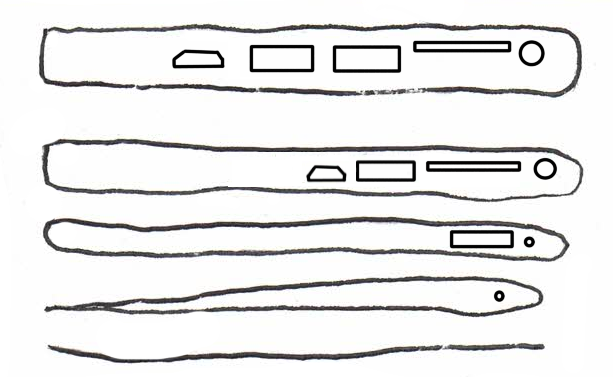What’s the final goal of these wafer-thin devices?
You’ve likely noticed it in your own electronics – they get thinner. New phone upgrades are thinner, new business or casual use laptops are thinner. Smaller. And it frequently comes at the cost of features.
There was a time when the phone’s camera was flush to the surface of the phone. Now, the phone’s thinner and the camera’s better, but the lens protrudes from the surface. There’s nowhere else for it to go. The plug-in parts of chargers slim down too, so they don’t hold the weight of the phone if it’s lying flat on the table and charging, but it makes the cord weaker.
Thinner has not yet become a problem at this stage.
Feature Loss
The Mac Pro was fast, cool-looking, cutting edge, and it was priced to match.
However… it lost its optical drive, the place you put DVDs and CDs on most computers. Optical drives are now available to buy separately, because the optical drive has a minimum thickness it has to be, so removing it is the only way to break past that barrier thickness. Folks still need them, though, for things like software downloads and old movies only stored on discs.
HDMI cables are also disappearing off the sides of devices (from all brands). USB ports are being cut, too. Much to the disappointment of photography fans, the SD card is no exception: Apple removed the SD card reader from their MacBook Pro, leaving them stuck with wireless connection. Supposedly this was done to encourage camera manufacturers to build a more robust wireless system, but it looks an awful lot like ditching useful features for the pursuit of a thinner device and selling them back to the customer with adaptors.
Apple’s not the only one falling into this trap, either! Dell laptops with no disc reader leave people with no ability to install older software stored on discs – if you upgrade your computer, you might very well be dragged into upgrading your printer, too, or downloading an emulator to play a game that you used to be able to play on your old computer. Optical readers can be expensive, especially if you spring for Apple’s name brand, on top of the ever-increasing cost of the actual computer.
What’s the goal, here? What is the final, perfect device? Shaving millimeters off at a time surely isn’t worth the cost of a separate optical drive, right? Eating away at features, boosting the price, all while selling the device as thinner?
Material Strength
Aluminum. It’s great. Lightweight, it’s an excellent conductor of heat, and it bends, instead of cracking, when under strain. It’s a popular choice for encasing machinery – planes, cars, and electronic devices all use aluminum or aluminum alloys to get that perfect lightweight strength. However, lately, electronics casings have been getting weaker. The cases bend. They twist. They flex, and put strain on the inside. Why? It’s still the same aluminum – but it’s thinner. The iPhone bending under weight wasn’t purely the aluminum’s fault, the whole dang thing was thinner, with a bigger screen!
There’s a ratio! Nobody wants the brick phone, but making the laptop into a pancake and removing features just to get thinner is becoming unsustainable. If you’re big into gaming, you might have noticed a recent trend towards mechanical keyboards for desktops – the buttons are big and chunky, and make a satisfying click when pressed. Bigger desktop machines with lights flashing inside them to show off the mechanical components are also rising in popularity. These increasingly thin laptops are sacrificing a lot of user experience all for the sake of being thinner than a single-subject notebook.
Not to forget feedback!
People generally like physical feedback – I can tell when I’ve missed a button just by sound on a regular keyboard, but on the slimmest of Macs, where the button barely depresses? Can’t tell. The buttons just don’t have enough space to make a clicking noise. I respect that! It’s incredible engineering, but it’s the kind of thing that drives users insane over time unless they didn’t want tactile feedback. I expect keyboards to be clicky, so when something subverts that expectation, it doesn’t feel right. Picture your last experience with mealy apples: you buy an apple, and bite into it expecting HoneyCrisp. Instead you get HoneyCrisp with a mealy texture. Nothing’s wrong with the apple… it’s just not what you expected.
At some point, a laptop can’t be as thin as a tablet. There’s just not enough places to shave off from, and yet computer maufacturers still try to get it to a quarter inch thick. It’s making the machine physically weaker, and worse at withstanding the user opening it. Can that paper-thin screen handle me opening it from the corner? It makes me deeply uncomfortable to try. Besides bending, blunt force trauma is also a bigger threat to thinner, lighter machines – there will be no ‘kinetic therapy’ for these machines. Less aluminum and thinner internal components means it suffers more when it’s dropped, too.
Please. Keep the laptops a little thicker. It already fits in the bag.
Sources:
https://www.apple.com/shop/product/MD564LL/A/apple-usb-superdrive
https://www.howtogeek.com/204867/how-to-use-cds-dvds-and-blu-rays-on-a-mac-without-an-optical-drive/
https://www.apple.com/shop/product/MD564LL/A/apple-usb-superdrive

